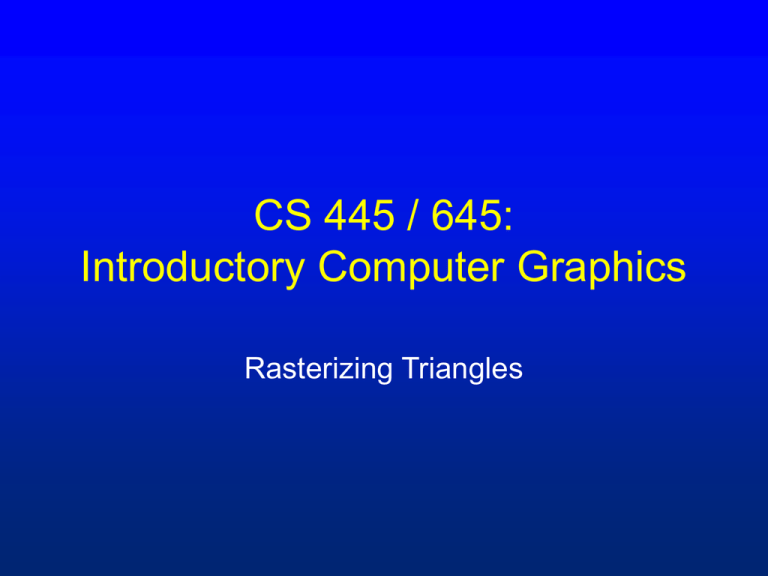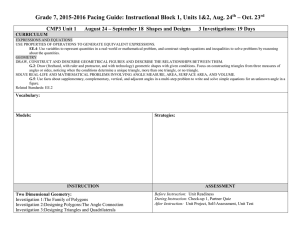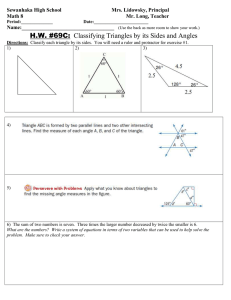CS 445 / 645: Introductory Computer Graphics Rasterizing Triangles
advertisement

CS 445 / 645:
Introductory Computer Graphics
Rasterizing Triangles
Review
Line rasterization
– Basic Incremental Algorithm
– Digital Differential Analyzer
Rather than solve line equation at each pixel, use
evaluation of line from previous pixel and slope to
approximate line equation
– Bresenham
Use integer arithmetic and midpoint discriminator to test
between two possible pixels (over vs. over-and-up)
Rasterizing Polygons
In interactive graphics, polygons rule the world
Two main reasons:
– Lowest common denominator for surfaces
Can represent any surface with arbitrary accuracy
Splines, mathematical functions, volumetric isosurfaces…
– Mathematical simplicity lends itself to simple,
regular rendering algorithms
Like those we’re about to discuss…
Such algorithms embed well in hardware
Rasterizing Polygons
Triangle is the minimal unit of a polygon
– All polygons can be broken up into triangles
Convex, concave, complex
– Triangles are guaranteed to be:
Planar
Convex
– What exactly does it mean to be convex?
Convex Shapes
A two-dimensional shape is convex if and
only if every line segment connecting two
points on the boundary is entirely contained.
Triangularization
Convex polygons easily triangulated
Concave polygons present a challenge
Rasterizing Triangles
Interactive graphics hardware commonly
uses edge walking or edge equation
techniques for rasterizing triangles
Edge Walking
Basic idea:
– Draw edges vertically
Interpolate colors down edges
– Fill in horizontal spans for each scanline
At each scanline, interpolate
edge colors across span
Edge Walking: Notes
Order three triangle vertices in x and y
– Find middle point in y dimension and compute if it
is to the left or right of polygon. Also could be flat
top or flat bottom triangle
We know where left and right edges are.
– Proceed from top scanline downwards
– Fill each span
– Until breakpoint or bottom vertex is reached
Advantage: can be made very fast
Disadvantages:
– Lots of finicky special cases
Edge Walking: Disadvantages
Fractional offsets:
Be careful when interpolating color values!
Beware of gaps between adjacent edges
Beware of duplicating shared edges
Edge Equations
An edge equation is simply the equation of
the line defining that edge
– Q: What is the implicit equation of a line?
– A: Ax + By + C = 0
– Q: Given a point (x,y), what does plugging x & y
into this equation tell us?
– A: Whether the point is:
On the line: Ax + By + C = 0
“Above” the line: Ax + By + C > 0
“Below” the line: Ax + By + C < 0
Edge Equations
Edge equations thus define two half-spaces:
Edge Equations
And a triangle can be defined as the
intersection of three positive half-spaces:
Edge Equations
So…simply turn on those pixels for which all
edge equations evaluate to > 0:
-+ +
+-
Using Edge Equations
Which pixels: compute min,max bounding box
Edge equations: compute from vertices
Orientation: ensure area is positive (why?)
Computing Edge Equations
Want to calculate A, B, C for each edge from
(x1, y1) and (x2, y2)
Treat it as a linear system:
Ax1 + By1 + C = 0
Ax2 + By2 + C = 0
Notice: two equations, three unknowns
What can we solve?
Goal: solve for A & B in terms of C
Computing Edge Equations
x0
Set up the linear system:
x1
y 0 A
1
C
y1 B
1
A
y1 y 0
C
B x 0 y1 x1 y 0 x1 x 0
Multiply both sides
by matrix inverse:
Let C = x0 y1 - x1 y0 for convenience
– Then A = y0 - y1 and B = x1 - x0
Edge Equations
So…we can find edge equation from two verts.
Given three corners C0, C1, C2 of a triangle,
what are our three edges?
How do we make sure the half-spaces defined
by the edge equations all share the same sign
on the interior of the triangle?
A: Be consistent (Ex: [C0 C1], [C1 C2], [C2 C0])
How do we make sure that sign is positive?
A: Test, and flip if needed (A= -A, B= -B, C= -C)
Edge Equations: Code
Basic structure of code:
– Setup: compute edge equations, bounding box
– (Outer loop) For each scanline in bounding box...
– (Inner loop) …check each pixel on scanline,
evaluating edge equations and drawing the pixel if
all three are positive
Optimize This!
findBoundingBox(&xmin, &xmax, &ymin, &ymax);
setupEdges (&a0,&b0,&c0,&a1,&b1,&c1,&a2,&b2,&c2);
/* Optimize this: */
for (int y = yMin; y <= yMax; y++) {
for (int x = xMin; x <= xMax; x++) {
float e0 = a0*x + b0*y + c0;
float e1 = a1*x + b1*y + c1;
float e2 = a2*x + b2*y + c2;
if (e0 > 0 && e1 > 0 && e2 > 0)
setPixel(x,y);
}
}
Edge Equations: Speed Hacks
Some speed hacks for the inner loop:
int xflag = 0;
for (int x = xMin; x <= xMax; x++) {
if (e0|e1|e2 > 0) {
setPixel(x,y);
xflag++;
} else if (xflag != 0) break;
e0 += a0; e1 += a1; e2 += a2;
}
– Incremental update of edge equation values
(think DDA)
– Early termination (why does this work?)
– Faster test of equation values
Triangle Rasterization Issues
Exactly which pixels should be lit?
A: Those pixels inside the triangle edges
What about pixels exactly on the edge?
– Draw them: order of triangles matters (it shouldn’t)
– Don’t draw them: gaps possible between triangles
We need a consistent (if arbitrary) rule
– Example: draw pixels on left or top edge, but not on
right or bottom edge
General Polygon Rasterization
Now that we can rasterize triangles, what
about general polygons?
We’ll take an edge-walking approach



